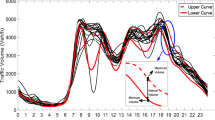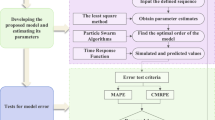Abstract
Traffic congestion is a major problem in the last few decades. Though the Government is taking various measures like installing more traffic signals, constructing fly-overs, one-ways, etc., the problem could not be addressed effectively on the heavily congested areas. The increasing number of vehicles, the dynamic population of traffic, the narrowness of roads and the absence of alternative roads or other routes are the major obstacles to reduce traffic congestion. Researchers of various streams have been working on predicting traffic volume to solve this problem. In this paper, a new method named Intuitionistic Fuzzy Grey-Markov Model(IFGMM) is introduced, which is an extension of Grey-Markov to Intuitionistic fuzzy set. The model is distinctive when compared with other models as it has a high level of accuracy performance. The forecasting result of this model is almost in proximity with the actual result of the traffic volume. In addition, the relative errors shown in this method are lesser than that of other models, due to its prediction accuracy is higher. Since the data collected in this method are taken from a heavily congested road from a metropolitan city, the proposed approach will be suitable for any congested area of the world.





Similar content being viewed by others
Explore related subjects
Discover the latest articles and news from researchers in related subjects, suggested using machine learning.References
Atanassov K (1986) Intuitionistic fuzzy sets. Fuzzy Sets Syst 20(1):87–96
Abdulhai B, Porwal H, Recker W (1999) Short-term freeway traffic flow prediction using genetically-optimized time-delay-based neural networks. University of California, Berkeley, Institute of Transportation Studies
Anton B, Gurcan C (2016) Short-term freeway traffic parameters prediction: applications of grey system theory models. Expert Syst Appl 62:284–292
Asrari A, Javan DS, Javidi MH, Monfared M (2012) Application of grey-fuzzy-Markov chain method for day-ahead electric load forecasting. Przeglad Elektrotechniczny 3:228–237
Badhrudeen M, Raj J, Vanajakshi L (2016) Short-term prediction of traffic parameters-performance comparison of a data-driven and less-data-required approaches. J Adv Transp 50:647–666
Chein S, Kuchipudi CM (2003) Dynamic travel time prediction with real time and historic data. J Transp Eng 129(6):608–616
Chen M, Chien S (2001) Dynamic freeway travel time prediction using probe vehicle data:link based versus path-based. Transportation Research Board,80th Annual meeting, Washington
Deng J (1989) Introduction to Grey system theory. J Grey Syst 1:1–24
Gong Y, Zhang Y (2013) Research of short term traffic volume prediction based on Kalman filtering. In: 6th international conference on intelligent networks and intelligent systems(ICINIS), China, pp 99-102
Gao S, Zhang Z, Cao C (2011) Road traffic freight volume forecasting using support vector machine combining forecasting. J Softw 6(9):1680–1687
Jiang X, Adeli H (2005) Dynamic wavelet neural network model for traffic flow forecasting. ASCE J Transp Eng 131(10):771–779
Jianwen X, Yuanbiao Z, Weigang J (2008) An improved Grey-Markov chain method with an application to predict the number of Chinese international airlines. International Symposium on Information Science and Engineering, pp 716–720
Jinlin M, Zhiqian C, Ken T (2013) Forecast of civil aviation freight volume using Unbiased-Grey-Fuzzy-Markov Chain Method. 6th International conference on information management, innovation management and industrial engineering, Xi’an, China, pp 23–24
Kisgyorgy L, Rilett LR (2002) Travel time prediction by advanced neural network. Period Polytech Serv Civ Eng 46(1):15–32
Lam WHK, Xu J (2000) Estimation of AADT from short period counts in Hong Kong-A comparison between neural network method and regression analysis. J Adv Transp 34(2):249–268
Lee Y (2009) Freeway travel time forecast using artificial neural networks with cluster method. 12th International Conference on Information Fusion, Seattle, WA, USA, pp 1331–1338
Li Q, Xia Q, Wang H (2012) Demand forecasting of port logistics based on GM(1,1)-Fuzzy Markov model. 2nd International Conference on Remote Sensing, Environment and Transportation Engineering, Nanjing, China
Nana G, Yeng Z, Yixiang S, Yunjian J, Dandan C (2015) Forecasting China’s annual biofuel production using an improved Grey model. Energies 8(10):12080–12099
Okutani I, Stephanedes YJ (1984) Dynamic prediction of traffic volume through Kalman filtering theory. Transp Res Part B Methodol 18(1):1–11
Olaleye OT, Sowunmi FA, Abiola OS, Salako MO, Eleyoowo IO (2009) A Markov Chain approach to the dynamics of vehicular traffic characteristics in abeokuta metropolic. Res J Appl Sci Eng Technol 1(3):160–166
Qi Y, Ishak S (2014) A Hidden Markov model for short term predicition of traffic conditions on freeways. Transp Res Part-C Emerg Technol 43(1):95–111
Smith BL, Demetsky MJ (1994) Short-term traffic flow prediction: neural network approach. Transp Res Rec J Transp Res Board 1453:98–104
Sharaf A, Wasan A, Rayouf A, Mohammad A (2020) Bayesian combined neural network for traffic volume short-term forecasting at adjacent intersections. Neural Comput Appl. https://doi.org/10.1007/s00521-020-05115-y
VanLint JWC, Hoogendoorn SP, VanZuylen HJ (2005) Accurate freeway travel time prediction with state-space neural networks under missing data. Transp Res Part-C Emerg Technol 13:347–369
Wang Y, Papageorgiou M (2005) Real-time freeway traffic state estimation based on extended Kalman filter: A general approach. Transp Res Part B Methodol 39(2):141–167
Xie Y, Zhang Y, Zhirui Y (2007) Short-Term traffic volume forecasting using Kalman filter with discrete wavelet decomposition. Comput Aided Civ Infrastruct Eng 22:326–334
Yang F, Yin Z, Liu HX, Ran B (2004) Online recursive algorithm for short-term prediction. Transp Res Rec J Transp Res Board 1878:1–8
Yin H, Wong SC, Xu CK (2002) Urban traffic flow prediction using a fuzzy-neural approach. Transp Res Part C Emerg Technol 28:85–98
Yisheng A, Hua C, Xiangmo Z (2012) Exploring grey system in traffic volume prediction based on tall database. Int J Digit Content Technol Appl 6(5):235–241
Zadeh LA (1965) Fuzzy sets. Inf Control 8:338–353
Zhang Y (2010) Predicting model of traffic volume based on Grey-Markov. Modern Appl Sci 4(3):46–50
Zhiheng Y, Tieli S, Hongguang S, Fengqin Y (2015) Research on combinational forecast models for the traffic flow. Math Prob Eng. https://doi.org/10.1155/2015/201686
Author information
Authors and Affiliations
Corresponding author
Ethics declarations
Conflict of Interest
The authors declare that they have no conflict of interest.
Additional information
Publisher's Note
Springer Nature remains neutral with regard to jurisdictional claims in published maps and institutional affiliations.
Rights and permissions
About this article
Cite this article
Govindan, K., Ramalingam, S. & Broumi, S. Traffic volume prediction using intuitionistic fuzzy Grey-Markov model. Neural Comput & Applic 33, 12905–12920 (2021). https://doi.org/10.1007/s00521-021-05940-9
Received:
Accepted:
Published:
Issue Date:
DOI: https://doi.org/10.1007/s00521-021-05940-9




